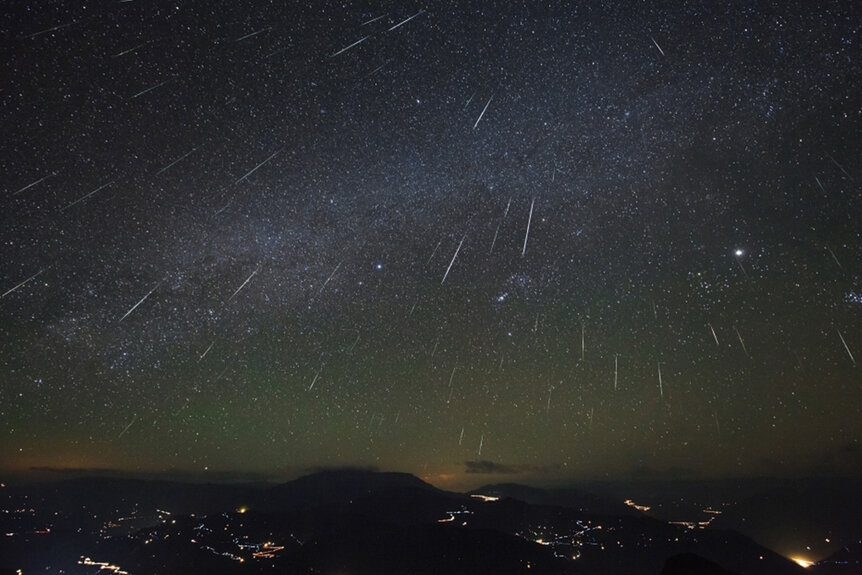Create a free profile to get unlimited access to exclusive videos, sweepstakes, and more!
The Geminids Meteor Shower Peaks This Week, Here's How to See Them
Look up!

The two-part TV miniseries Meteor (streaming now on Peacock) tells a familiar tale of humanity on the brink of extinction. A meteor called Kassandra is on a collision course with our planet and the fate of our species hangs in the balance. If anyone can save us, it will be through the combined efforts of Christopher LLoyd, Michael Rooker, Jason Alexander, and Ernie Hudson.
In reality, our planet has close encounters with flying space rocks all the time. NASA’s Center for Near-Earth Object Studies (CNEOS) keeps an eye on the debris in our general vicinity to call out anything which might make us the stars of a real-life disaster flick. Most of those objects fly past us without incident and the rest largely burn up on their way toward the surface. But some of those near misses leave a fingerprint in space which we experience as meteor showers every year.
The Geminid Meteor Shower Peaks December 13
We are currently in the midst of what might be the best meteor shower of the year. The Geminid meteor shower made its first appearance in the 1800s, but they were relatively weak at the time. Stargazers a couple centuries ago would have seen only 10 - 20 shooting stars per hour. Since then, the shower has grown in strength, becoming more active over the centuries.
RELATED: “Boomerang Meteorite” Left Earth, Went to Space, Then Came Back
You can see the shower all over the world and you don’t need to look in any particular direction to see it. However, meteorites do appear to radiate from the constellation Gemini, which is where the shower gets its name. Dedicated observers started seeing the Geminids in mid-November and the shower will continue through late December, peaking the evening of December 13.
If you’re hoping to see a few shooting stars yourself, this is a particularly good year to do it. The shower’s peak nearly coincides with the new Moon, which means there will be less light pollution than if we were in another part of the lunar cycle. Next year’s peak will coincide with a nearly full Moon, which will make the shower more difficult to see.
How to See the Geminid Meteor Shower
Provided you’ve got clear skies, you shouldn’t have much trouble seeing a shooting star or two, but you can take steps to improve your experience. Getting away from the city and other forms of light pollution will make faintly burning objects more easily visible. Once you’ve found your skywatching spot, just look up at the night sky and wait. It can take about 30 minutes for your eyes to fully adjust; be patient and the shower will come.
Like all meteor showers, the Geminids are caused by leftover bits of a larger object burning up in our atmosphere. Most meteor showers are caused by comets which leave pieces of their trailing tails behind them like cosmic bread crumbs. Every year, when our orbit brings them through the comet’s path, we hit those leftover pieces of their tails and are treated to a light show. The Geminids, however, are special. They are believed to be generated by a bizarre space rock called Phaethon.
RELATED: New Observations Reveal the Bizarre Origin of the Asteroid Phaethon and the Geminids Meteor Shower
Shooting stars should start showing up in the sky between 9:00 and 10:00 P.M. local time, but the show gets better later on. Make sure to bundle up against the cold winter weather to get the best view. You can spend all night watching if you want, the show will keep going until the Sun comes up and washes it out. At its peak, meteors will be entering the atmosphere at 127,000 kilometers (79,000 miles) per hour at a rate of roughly 120 per hour. You’ll also notice that the Geminid meteor shower lights up in a brilliant green hue.
“Most meteors appear to be colorless or white, however the Geminids appear with a greenish hue. They’re pretty meteors!” said Bill Cooke, Meteoroid Environment Office at NASA, in a statement.
Scientists believe the green coloration is likely due to the asteroid’s unique chemical composition. Its rich oxygen, magnesium, and nickel makeup burn a fierce green during entry. Of course, you don’t need to know that to know that it’s beautiful.
Catch the Geminids streaming through the night sky tonight, and catch Meteor streaming now on Peacock.




























